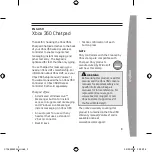
- 17 -
once the receiving system, including the antenna system and the receiver, are hearing the lowest
possible level of local and propagated ambient noise, antenna directivity (F/R) is the only thing that
affects the signal-to-noise ratio.
The default direction of the array with no voltage (BCD 000) places
elements 1 and 6 in front and elements 2 and 5 at the rear. Pairs of
lines through two opposite vertical element pairs (tangents) point
toward the receiving directions. Elements 1, 2 and 5, 6 are selected
as the default, for a forward direction of North-East, with elements
installed as shown for North America. A mirror image of this
element positioning would be a typical default direction of North-
West for European installations.
This array can use active or passive elements. Passive elements provide the greatest dynamic range
and immunity to overload. Active elements provide the widest system bandwidth, but at the expense
of dynamic range.
Receiving antennas work best when they have a clean pattern with narrowest possible lobe, and
minimal spurious lobes. This is because noise generally comes from many directions, while a signal
comes from one useful direction at a time. If a signal comes from multiple angles or directions we
still do not want those directions, because the phase relationship and levels of the multiple path
single source signal will vary a great deal. This will cause undesirable fading and distortion. We
cannot successfully directly mix multiple antennas for diversity reception for the same reasons we
do not want an antenna to respond to the same signal source over multiple paths, since we cannot
combine randomly varying phase and level signals without increasing fading or reducing signal-to-
noise (S/N) ratio.
Note: The
DXE-RCA8B
Eight Circle Receiving Array System should be separated
from transmitting or other antennas and structures (particularly metal) by at least
1/2-wavelength. Less separation may cause significant pattern distortion and the
introduction of re-radiated noise into the system. This becomes apparent as
reduced front-to-rear directivity in one or more directions or a higher noise level.
With so many variables involved, there is no optimum or minimum spacing for
effects on pattern. The best practice is to install the array as far as possible from
tall conductors or noise sources, or place potential problems in less frequently
used directions. For best pattern, space the system as far as possible from
conductors that might be noise sources or re-radiate unwanted signals. One
wavelength or more is generally ideal, although adequate performance generally
occurs with much smaller spacing.
There is no detrimental effect when a higher frequency array of small receiving
elements is placed inside the circle of a lower frequency array of short elements.
















































